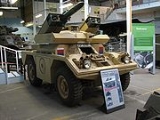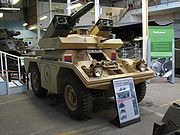
Swingfire
Unanswered Questions
Encyclopedia
Swingfire was a British
wire-guided
anti-tank missile
developed in the 1960s and produced from 1966 until 1993.
. It replaced the Vickers Vigilant
missile in British service. It was a product of both its predecessor the Vigilant and the experimental Orange William missile.
The name comes from the ability of the missile to make a rapid turn of up to ninety degrees after firing to bring it onto the line of the sighting mechanism. This means that the launcher vehicle can be concealed and the operator, using a portable sight, placed at a distance in a more advantageous firing position.
Besides its use on the FV438 Swingfire
and the Striker
armoured vehicles, Swingfire was developed to be launched from other platforms:
in mid-2005 to meet new and changing situational requirements. The British Army invested heavily in the Javelin, and it is now the main heavy anti-tank missile system in use by the British Army.
: Egyptian Army
:
: Kenyan Army
 Nigeria: Nigerian Army
Nigeria: Nigerian Army
: Portuguese Army
:
: Saudi Arabian Army
 : SPAF
: SPAF
: British Army
in March 2002 when 20 warheads, removed for decommissioning, were washed into the Bristol Channel
along with 8 anti-tank mine
s. The warhead
s, with a total explosive weight equivalent to 64.2 kg of TNT, were never located.
United Kingdom
The United Kingdom of Great Britain and Northern IrelandIn the United Kingdom and Dependencies, other languages have been officially recognised as legitimate autochthonous languages under the European Charter for Regional or Minority Languages...
wire-guided
Wire-guided missile
A wire-guided missile is a missile that is guided by signals sent to it via thin wires connected between the missile and its guidance mechanism, which is located somewhere near the launch site. As the missile flies, the wires are reeled out behind it...
anti-tank missile
Anti-tank guided missile
An anti-tank missile , anti-tank guided missile , anti-tank guided weapon or anti-armor guided weapon is a guided missile primarily designed to hit and destroy heavily-armored military vehicles....
developed in the 1960s and produced from 1966 until 1993.
Development
Swingfire was developed by Fairey Engineering Ltd and the British Aircraft CorporationBritish Aircraft Corporation
The British Aircraft Corporation was a British aircraft manufacturer formed from the government-pressured merger of English Electric Aviation Ltd., Vickers-Armstrongs , the Bristol Aeroplane Company and Hunting Aircraft in 1960. Bristol, English Electric and Vickers became "parents" of BAC with...
. It replaced the Vickers Vigilant
Vickers Vigilant
The Vickers Vigilant was a British MCLOS wire guided anti-tank missile used by the British Army. It was licence-built for the US Marine Corps by Clevite in the USA.-History:...
missile in British service. It was a product of both its predecessor the Vigilant and the experimental Orange William missile.
The name comes from the ability of the missile to make a rapid turn of up to ninety degrees after firing to bring it onto the line of the sighting mechanism. This means that the launcher vehicle can be concealed and the operator, using a portable sight, placed at a distance in a more advantageous firing position.
Besides its use on the FV438 Swingfire
FV438 Swingfire
The FV438 Swingfire was an armoured anti-tank vehicle of the British Army.It was derived from the FV430 series of vehicles by converting the FV432 to accommodate a launcher for Swingfire anti-tank guided missiles....
and the Striker
FV102 Striker
The FV102 Striker was the anti-tank guided missile carrier in the CVR family and served in the British Army.-Overview:FV102 Striker was the Swingfire wire guided anti-tank missile carrying member of the CVR family. The FV102 Striker was externally very similar to the FV103 Spartan but carried five...
armoured vehicles, Swingfire was developed to be launched from other platforms:
- Beeswing - on a Land Rover
- Hawkswing - on a Lynx helicopter
- Golfswing - on a small trolley or Argocat vehicle.
Replacement in British Army
After a lengthy debate, the Swingfire was replaced with the JavelinFGM-148 Javelin
The FGM-148 Javelin is a United States-made man-portable third generation anti-tank missile fielded to replace the Dragon antitank missile.-Overview:Javelin is a fire-and-forget missile with lock-on before launch and automatic self-guidance...
in mid-2005 to meet new and changing situational requirements. The British Army invested heavily in the Javelin, and it is now the main heavy anti-tank missile system in use by the British Army.
Specification
- Diameter: 170 mm
- Wingspan: 0.39 m
- Length: 1.07 m
- Weight: 27 kg
- Warhead: 7 kg HEATHeatIn physics and thermodynamics, heat is energy transferred from one body, region, or thermodynamic system to another due to thermal contact or thermal radiation when the systems are at different temperatures. It is often described as one of the fundamental processes of energy transfer between...
- Range: 150 m to 4000 m
- Velocity: 185 m/s
- Guidance: Wire-guided, originally MCLOSMCLOSMCLOS is a first-generation method for guiding guided missiles.With an MCLOS missile, the operator must track the missile and the target simultaneously and guide the missile to the target. Typically the missile is steered with a joystick, and its path is observed through a periscope-type...
, later upgraded to SACLOSSACLOSSACLOS is an acronym for Semi-Automatic Command to Line of Sight, a second-generation method of missile guidance. In SACLOS, the operator has to continually point a sighting device at the target while the missile is in flight...
, in which form the system is known as SWIG (Swingfire With Improved Guidance). - Steering: Thrust VectoredThrust vectoringThrust vectoring, also thrust vector control or TVC, is the ability of an aircraft, rocket or other vehicle to manipulate the direction of the thrust from its engine or motor in order to control the attitude or angular velocity of the vehicle....
Control (TVC) - Penetration: 800 mm RHA
- Unit cost: £7,500
Operators
: Belgian ArmyBelgian Army
The Land Component is organised using the concept of capacities, whereby units are gathered together according to their function and material. Within this framework, there are five capacities: the command capacity, the combat capacity, the support capacity, the services capacity and the training...
- FV102 StrikerFV102 StrikerThe FV102 Striker was the anti-tank guided missile carrier in the CVR family and served in the British Army.-Overview:FV102 Striker was the Swingfire wire guided anti-tank missile carrying member of the CVR family. The FV102 Striker was externally very similar to the FV103 Spartan but carried five...
: Egyptian Army
Egyptian Army
The Egyptian Army is the largest service branch within the Egyptian Armed Forces and holds power in the current Egyptian government. It is estimated to number around 379,000, in addition to 479,000 reservists for a total of 858,000 strong. The modern army was created in the 1820s, and during the...
- Swingfire missiles were also produced in Egypt under license by Arab-British Dynamics.
:
: Kenyan Army
 Nigeria: Nigerian Army
Nigeria: Nigerian ArmyNigerian Army
The Nigerian Army the largest of the Nigerian Armed Forces, has about 100,000 professional personnel. The original elements of the Royal West African Frontier Force in Nigeria were formed in 1900....
: Portuguese Army
Portuguese Army
The Portuguese Army is the ground branch of the Portuguese Armed Forces which, in co-operation with other branches of the Portuguese military, is charged with the defence of Portugal...
- Used on the Chaimite armoured fighting vehicle, now retired.
:
: Saudi Arabian Army
Saudi Arabian Army
The Saudi Arabian Army , also called Royal Saudi Land Force . Is a branch of the Saudi Armed Forces. The total number of active troops is estimated to be 233,500The current Chief of the Saudi General Staff is Field Marshal Saleh Al-Muhaya....

Military of Sudan
The Sudanese Armed Forces numbers, according to 2007 IISS estimates, 104,800 members supported by 17,500 paramilitary personnel.It comprises Land Forces, a Navy, an Air Force, and the Popular Defence Force. It has also formed Joint Integrated Units with its rebel enemies the Sudan People's...
: British Army
British Army
The British Army is the land warfare branch of Her Majesty's Armed Forces in the United Kingdom. It came into being with the unification of the Kingdom of England and Scotland into the Kingdom of Great Britain in 1707. The new British Army incorporated Regiments that had already existed in England...
- FV102 Striker - 5 in ready-to-fire bins.
- FV438 SwingfireFV438 SwingfireThe FV438 Swingfire was an armoured anti-tank vehicle of the British Army.It was derived from the FV430 series of vehicles by converting the FV432 to accommodate a launcher for Swingfire anti-tank guided missiles....
- Two firing bins - Ferret Mk 5Ferret armoured carThe Ferret armoured car, also commonly called the Ferret Scout car, is a British armoured fighting vehicle designed and built for reconnaissance purposes. The Ferret was produced between 1952 and 1971 by the UK company, Daimler...
- Four firing bins.
Decommissioning problems
Swingfire inadvertently became the subject of questions in the Houses of ParliamentPalace of Westminster
The Palace of Westminster, also known as the Houses of Parliament or Westminster Palace, is the meeting place of the two houses of the Parliament of the United Kingdom—the House of Lords and the House of Commons...
in March 2002 when 20 warheads, removed for decommissioning, were washed into the Bristol Channel
Bristol Channel
The Bristol Channel is a major inlet in the island of Great Britain, separating South Wales from Devon and Somerset in South West England. It extends from the lower estuary of the River Severn to the North Atlantic Ocean...
along with 8 anti-tank mine
Anti-tank mine
An anti-tank mine, , is a type of land mine designed to damage or destroy vehicles including tanks and armored fighting vehicles....
s. The warhead
Warhead
The term warhead refers to the explosive material and detonator that is delivered by a missile, rocket, or torpedo.- Etymology :During the early development of naval torpedoes, they could be equipped with an inert payload that was intended for use during training, test firing and exercises. This...
s, with a total explosive weight equivalent to 64.2 kg of TNT, were never located.

